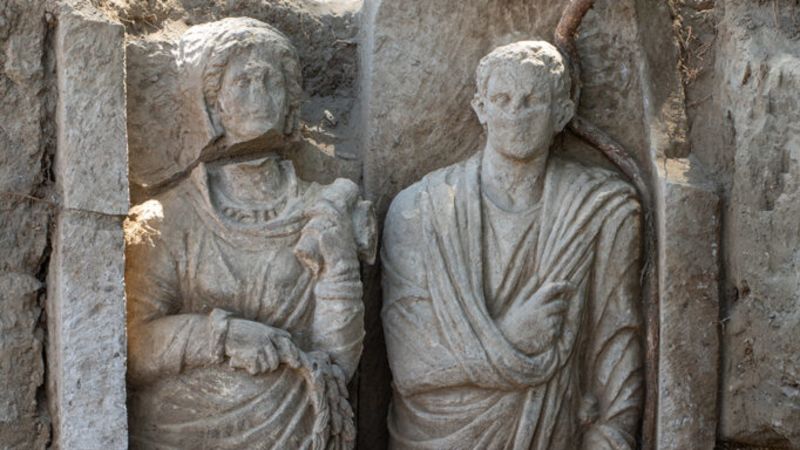Recent archaeological explorations in Pompeii have yielded remarkable findings, including the discovery of two nearly life-sized marble funerary statues during an excavation of a massive tomb just outside the ancient city’s Porto Sarno entrance gates. This revelation provides an enthralling glimpse into the societal structures and religious practices of a civilization that was decimated by the catastrophic eruption of Mount Vesuvius in 79 AD. These statues, depicting a man draped in a toga and a woman in elaborate attire, not only offer insight into the artistic craftsmanship of the era but also illuminate the previously overlooked status of priestesses in ancient Pompeii.
According to the experts at the Pompeii archaeological park, both statues are openings to understanding the religious hierarchy of their time. The female statue, adorned with jewels—earrings, bracelets, rings, and a notable crescent moon pendant—suggests her significant role within the religious landscape. The crescent moon necklace traditionally worn by priestesses of the cult of Ceres—a goddess often associated with fertility and agriculture—implies that this woman held a position of reverence. The importance of the “lunula,” or crescent ornament, resonates throughout ancient cultures, symbolizing not just femininity and fertility but also protection from malevolent forces during critical transitions such as childbirth and marriage. This multi-layered interpretation underlines the significance of the cult to which she likely belonged.
The presence of the man alongside the woman raises intriguing questions about their relationship. Gabriel Zuchtriegel, the director of the Pompeii archaeological park, posits that the asymmetrical prominence in their adornments may indicate that they were not married, with the man possibly serving as a priest or even the woman’s son. This hypothesis opens the door for broader discussions about familial ties and social structures in a society known for its intricate interpersonal dynamics.
The excavation of Pompeii has been an ongoing endeavor since the 1700s when the city was first uncovered beneath layers of volcanic ash and rock. Despite the numerous findings over the centuries, the current exploration—dubbed the Investigating the Archeology of Death in Pompeii Research Project—has turned a specific spotlight on a burial site first exposed in 1998 during the construction of a train line linking Naples to the site. Recent efforts led by Spanish archaeologist Llorenç Alapont, in partnership with the University of Valencia, have revealed more than 50 cremation burial sites, enriching our understanding of the funerary practices that prevailed in ancient Roman society.
Zuchtriegel praised the partnership with the University of Valencia as vital to piecing together the archaeological narrative that envelops Pompeii. The collaborative efforts have extended to a multidisciplinary approach involving architects, restorers, and anthropologists, illustrating the complexity and depth of the investigation. The site has already produced other significant finds, including mummified remains discovered in a tomb dedicated to Marcus Venerius Secundio, adding to the historical tapestry being woven from excavated artifacts.
The statues, assigned to the category of funerary reliefs crafted between the late 1st century BC and early 1st century AD, are rare not just in Pompeii but throughout southern Italy. Alapont pointed out that the artistic significance of these statues implies a vibrant cult of Ceres in the region, suggesting the presence of priestesses was a considerable feature of Pompeian society. He remarked on the unusual depiction of priestesses in such grandeur, indicating that priestly roles may have been predominantly held by women of a certain social class, thereby reflecting societal layers in ancient Roman culture.
In a bid to preserve and appreciate these artworks, the statues have been relocated to the Palestra Grande, Pompeii’s largest open space. They are slated to be featured in an upcoming exhibition focusing on women’s roles in ancient Pompeii, set to commence on April 16. This exhibition promises to further illuminate the lives of women in ancient Roman society, celebrating their significant contributions to religious practices, social structures, and cultural narratives during a time when their voices were often marginalized. Thus, the ongoing excavation work and subsequent exhibitions act as both preservation of the past and education for future generations, enriching our collective understanding of this historically significant civilization.












